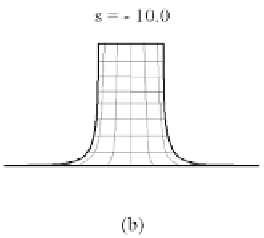Graphics Reference
In-Depth Information
Figure 15.23.
Blending as a boundary value problem.
solution.) Varying these parameters generates different blends and their effect can be
described geometrically. Figure 15.23 shows cross-sections of the solutions corre-
sponding to s =-0.1 and -10.0 for a fixed parameter a.
Finally, as is the case for most solutions to geometric modeling problems, after
one has a basic idea for a solution one usually has to deal with a number of “details.”
In the case of blending, aside from the usual issues of robustness and efficiency, there
are some topological issues. If one is blending an edge, what does one do at the ends
of the edge? A vertex by itself can be dealt with by defining a trimline and filling in a
patch. Ends of edges are more complicated. There may be several edges ending in the
same vertex. See [ViMV94] for this nontrivial problem and ways to deal with it.
15.7
P
ROGRAMMING
P
ROJECTS
Section 15.3.1
15.3.1.1
Let a user pick two points on a surface. Use the second point to define a direction
and then generate a smooth geodesic starting at the first point and going in that
direction.
Section 15.5
15.5.1
Have the user pick a surface and then define a space curve whose data was read from
a file. Drop this curve onto the surface.
Section 15.6
15.6.1
Implement one of the blending techniques for curves.





